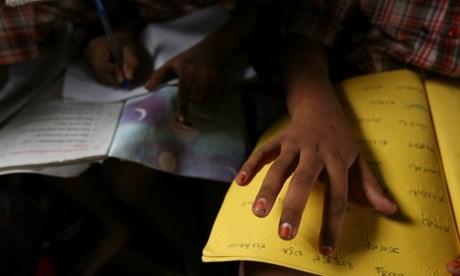
Article by P Rajasekharan in Chennai In India, disabled people are excluded from microfinance due to ill thought out systems. How can we change attitudes?
A visually challenged student reads from the Braile script in Karnataka, IndiaPhotograph: Amit Bhargava/Amit Bhargava/Corbis
Microfinance institutions (MFIs) in India have helped transform the lives of more than 80 million poor people through small loans, according to Microfinance India’s state of the sector report in 2012. But why have they remained out of reach for more than 70 million people with disabilities?
Kavitha, a construction worker, became blind after an acid attack by her husband. Having heard of programmes to support disabled people start a business, she reached out to government departments, local banks and even local moneylenders but found people were reluctant to support her because of her disability.
Kavitha’s experience is not unusual. In a study we at v-shesh conducted with the Accion Centre for Financial Inclusion (CFI), we found the attitude of MFI loan officers and the wider community are the biggest barriers to disabled clients accessing microfinance. Inaccessible processes at MFI were also holding disabled clients back. For example, a blind person has to to depend on others to read her passbook and a deaf person might miss out on crucial loan-related information during training.
To tackle these problems, we partnered with three Indian MFIs,Annapurna, the Evangelical Social Action Forum (ESAF) and Equitas in June 2013 to develop an operating model for disability-inclusive microfinance.
We ran a two-day disability awareness training programme for 25-30 staff from each MFI on disability myths and facts, universal design principles, and an introduction to sign language, and then organised role plays on putting these skills into action.
We wanted to emphasise that making everything accessible is not necessarily a difficult concept but includes simple solutions like punching holes in the passbook for a blind person to identify it from other documents or delivering cash to a person with a mobility problem, rather than making them come to a branch.
Initial results are encouraging – the acquisition rate for clients with disabilities has increased from 100 per month (in June 2013, pre-training) to 250 per month (from Jan 2014, post-traning), according to John Alex, head of social initiatives at Equitas.
During training, a few operating teams explained how working alongside disabled co-workers is a powerful way to change attitudes, so we wanted to further encourage inclusive hiring.
To do this, v-shesh conducted sessions for hiring managers highlighting the business case for disabled hiring and identified positions that could be staffed by people with disabilities. Since then, Annapurna hired two deaf people for data-processing roles alongside several people with reduced mobility for office-based roles. A pilot is now being discussed to hire blind staff in Equitas’ Chennai call centre.
Disability access audits were also used to further help identify “points of inaccessibility” in processes and systems. Important document (passbooks, application forms, receipts etc) are now being converted into accessible formats using tactile markings and audio/video formats in local languages. Clear instructions have also been issued to staff through office memos and the training manual to allow disabled clients to bring an accompanying person for all interactions – previously, only group members were allowed to attend meetings to stop them sending a proxy which would harm group bonding.
To reinforce disability inclusive behaviour MFIs give awards to branches that perform well in inclusion. All the three MFIs have started tracking the performance of more than 500 branches across Tamil Nadu, Maharashtra, Orissa, Madhya Pradesh and Kerala.
Our remaining challenge, though, is to better engage with organisations for disabled people (DPOs). They and MFIs rarely interact which has led to negative perception about each other. To bridge this divide, field visits to MFI operations sites are being organised for both groups to clarify each other’s concerns. For example, DPOs perceive that interest rates charged by MFIs are very high, so we had to explain their interest rate is within the limits prescribed by the central bank. MFIs realise local organisations for disabled people enjoy the confidence of many disabled people, and regular interactions with them will be imperative to reach more disabled clients.
Kavitha, who now runs a business off an MFI loan, and 13,000 other disabled clients (as of August 2014) are now being better served by the MFIs in India.
For us, what worked with MFIs and borrowers are real world solutions that emerged mainly from the frontline officers through client-centred thinking. Making our courses available online for a small charge would be the next step in scaling up. However, it will take some time to gather data to build a business case, around cost recovery and scale. Once we have that business case, the next steps for the programme are for this to be expanded to more MFIs in India, as well as in south-east Asia and Africa. Our model is applicable to all institutions in India and we hope the government will play a more effective role as an advocator for disability inclusion, both through policy measures and offering incentives for businesses to be more disability-inclusive.
Go to the original article
